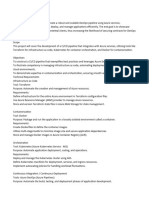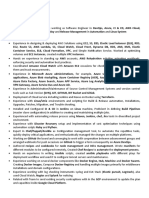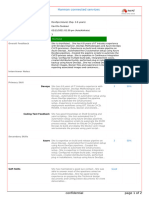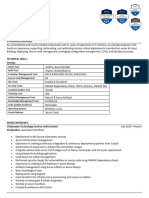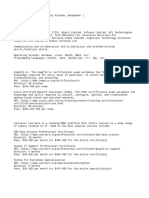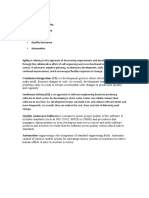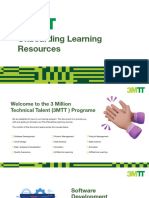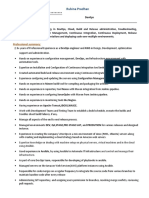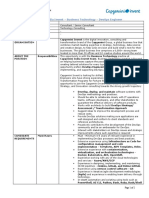Azure DevOps Engineer Interview Guide: Story-Based Scenarios
Introduction
This document presents realistic story-based scenarios that simulate real-world challenges faced by DevOps
engineers working with Azure, Kubernetes, Docker, and Azure DevOps. Each scenario includes both
interview questions and comprehensive answers to help candidates prepare for technical interviews.
https://www.linkedin.com/in/saraswathilakshman/
https://saraswathilakshman.medium.com/
�Company Background: CloudNative Solutions Inc.
You’re interviewing for a Senior DevOps Engineer position at CloudNative Solutions Inc., a rapidly growing
SaaS provider. The company has recently decided to modernise their infrastructure by migrating to Azure
Kubernetes Service (AKS) and implementing robust CI/CD pipelines using Azure DevOps. You’ll face technical
scenarios from different team members who want to assess your expertise.
Scenario 1: The Failing Pipeline
Context: Sarah, the lead developer, approaches you with frustration.
“Our Azure DevOps pipeline for the payment microservice has been failing intermittently for the past week. The
builds succeed on developers’ machines but fail about 30% of the time in the pipeline with Docker build errors.
It’s blocking our releases, and we must fix it ASAP.”
Interviewer Question: “How would you approach troubleshooting and resolving this issue?”
Strong Answer:
“I’d approach this systematically:
First, I’d examine the pipeline logs to identify patterns in the failures. Since it’s intermittent, I’d compare
successful and failed runs to spot differences.
For Docker build failures, I’d focus on:
1. Base image availability — Is DockerHub or our private registry experiencing issues?
2. Resource constraints — Is the build agent running out of memory or disk space during larger builds?
3. Race conditions — Are there parallel processes interfering with each other?
4. Network dependencies — Are there unreliable external dependencies in the Dockerfile?
I’d implement immediate mitigations:
https://www.linkedin.com/in/saraswathilakshman/
https://saraswathilakshman.medium.com/
� • Configure retry logic for network-dependent steps
• Increase resource allocation for build agents if necessary
• Cache Docker layers to speed up builds and reduce external dependencies
For a long-term solution, I’d:
• Set up build agent health monitoring
• Implement a local registry mirror to prevent DockerHub rate-limiting issues
• Review the Dockerfile for best practices and optimise it
• Add comprehensive logging to the build process
In a previous role, we faced similar issues and traced them to DockerHub rate limits. We implemented Azure
Container Registry with geo-replication as our primary registry and added layer caching, which improved
build reliability from 70% to 99.8%.”
Scenario 2: AKS Monitoring Crisis
Context: It’s 2 AM and your phone rings. Alex, the on-call engineer, sounds panicked.
“The production AKS cluster is showing high latency, and several pods are crash-looping. Our monitoring
dashboard shows that CPU and memory utilisation are normal, but users are reporting timeouts. The last
deployment was three days ago, and everything was fine until an hour ago.”
Interviewer Question: “What would be your immediate steps to diagnose and resolve this issue?”
Strong Answer:
“Even at 2 AM, I’d approach this calmly and methodically:
Immediate triage:
https://www.linkedin.com/in/saraswathilakshman/
https://saraswathilakshman.medium.com/
� 1. Check AKS control plane health and system pods in the kube-system namespace
2. Review Azure Service Health for any regional outages affecting AKS or dependent services
3. Examine pod logs for the crashing services using kubectl logs or Azure Log Analytics
4. Check network metrics and Kubernetes events for signs of DNS issues or network policies causing
timeouts
5. Look for recent automatic actions like node upgrades or auto-scaling events
Since CPU and memory look normal, I’d investigate:
• Network connectivity between services and to external dependencies
• Storage performance if the services are stateful
• Service mesh configuration, if implemented (like Istio or Linkerd)
• Recently rotated secrets or certificates that might have expired
For immediate mitigation if needed:
• Scale out the affected deployments to ensure some healthy pods can handle traffic
• Consider rolling back to a known-good state if we can identify a change that triggered this
• Temporarily increase resource limits if throttling is suspected
In a similar incident at my previous company, we discovered that a cloud provider’s automatic security patch
had affected the CNI plugin's performance. We mitigated by restarting the affected nodes in a controlled
rotation and then worked with Azure support to get the proper fix applied.
Post-incident, I’d ensure we enhance our monitoring to include network latency metrics, successful request
percentages, and API server response times to catch similar issues earlier.”
https://www.linkedin.com/in/saraswathilakshman/
https://saraswathilakshman.medium.com/
�Scenario 3: Multi-Environment CI/CD Pipeline Design
Context: You’re meeting with Maria, the CTO, who is concerned about deployment consistency.
“We’re expanding to serve healthcare clients who require stringent compliance. We currently have a simple
pipeline that builds and deploys directly to production. We need a robust multi-environment pipeline with
proper controls and validation. Design a solution using Azure DevOps that ensures security, compliance, and
efficiency.”
Interviewer Question: “Describe your approach to designing a multi-environment CI/CD pipeline in Azure
DevOps that meets these requirements.”
Strong Answer:
“I’d design a comprehensive pipeline architecture that balances security, compliance, and developer
productivity:
For the CI pipeline:
1. Implement branch policies requiring pull request approvals before merging to main
2. Configure static code analysis with SonarQube integration
3. Run security scanning using Microsoft Defender for DevOps and container scanning
4. Execute comprehensive automated testing (unit, integration, API)
5. Generate signed artifacts with version tracking
6. Publish build results and test coverage to Azure DevOps dashboards
For the CD pipeline, I’d create a multi-stage approach:
Dev Environment: Automatic deployment triggered by successful CI
• Feature branch deployments using Helm with unique namespaces for isolation
https://www.linkedin.com/in/saraswathilakshman/
https://saraswathilakshman.medium.com/
� • Dynamic resource scaling (lower limits to save costs)
• Synthetic testing after deployment
Test/QA Environment: Semi-automated with quick approval
• Integration testing across services
• Performance testing with Azure Load Testing
• Security validation and compliance checks
• Configuration drift detection
Staging Environment: Production-like with formal approvals
• Replicated production data structure (anonymised)
• Chaos testing for resilience validation
• Full UAT testing
• Deployment using identical methods as production
Production Environment: Scheduled deployment with approval gates
• Progressive deployment using traffic shifting
• Automated pre- and post-deployment health checks
• Automated rollback capabilities based on health metrics
• Compliance audit logging
I’d implement environment-specific configurations using:
• Key Vault integration for secret management
https://www.linkedin.com/in/saraswathilakshman/
https://saraswathilakshman.medium.com/
� • Separate key vaults per environment with appropriate RBAC
• Automatic secret rotation with managed identities
• Variable groups with approval workflows for changes
• Configuration validation as part of deployment
For healthcare compliance:
• Implement segregation of duties using Azure DevOps permissions
• Comprehensive audit logging of all pipeline activities
• Evidence collection for compliance certification
• Automated compliance checks using Azure Policy
In my experience implementing similar pipelines, the key success factor was creating a “golden path” that
made it easier for developers to follow secure practices than to work around them, while still maintaining
the necessary controls that healthcare compliance requires.”
Scenario 4: Container Optimisation Crisis
Context: The engineering manager, Jason, calls an urgent meeting.
“Our Azure costs have doubled this month! Looking at the billing, our AKS clusters are the main culprit. The
containers we’re deploying are huge (4GB+), and developers are requesting more resources as the application
keeps growing. We need to optimise our container strategy ASAP.”
Interviewer Question: “How would you approach optimising our Docker containers and Kubernetes
resource utilisation to reduce costs?”
Strong Answer:
https://www.linkedin.com/in/saraswathilakshman/
https://saraswathilakshman.medium.com/
�“I’d approach this as both an immediate cost-saving initiative and a longer-term optimisation strategy:
For immediate Docker image optimisation:
Audit existing Dockerfiles across all services and identify common issues:
• Using bloated base images instead of slim or Alpine variants
• Inefficient layer caching is causing redundant content
• Development dependencies included in production images
• Temporary files are not cleaned up within layers
Implement multi-stage builds to separate build and runtime environments
• Example: For a .net application, use SDK image for building but the runtime image for the final
container
• This alone typically reduces image size by 60–80%
Standardise on minimal base images appropriate for each workload
• Alpine Linux where compatible
• Distroless images for additional security and size benefits
• Custom golden images with only the required components
For Kubernetes resource optimisation:
1. Implement right-sizing based on actual usage metrics:
• Deploy Prometheus and Grafana to collect historical resource utilisation
• Analyse CPU/memory usage patterns across different workloads
• Set appropriate requests based on P95 usage and limits based on peak needs
https://www.linkedin.com/in/saraswathilakshman/
https://saraswathilakshman.medium.com/
�2. Review Pod specifications for resource efficiency:
• Implement horizontal autoscaling instead of over-provisioning
• Use pod disruption budgets to ensure stability during scaling
• Configure startup and liveness probes correctly to prevent unnecessary restarts
3. Optimise cluster configuration:
• Implement node auto-scaling to match workload patterns
• Use appropriate VM sizes for different workload profiles
• Consider Azure Spot Instances for non-critical workloads
• Implement cluster autoscaler to scale nodes based on pod demand
Establish governance and education:
• Create container size and resource request limits as pull request policies
• Build automated cost reporting dashboards per team/service
• Conduct training sessions on container optimisation techniques
In my previous role, we implemented a similar optimisation initiative and reduced our container sizes by 78%
on average while cutting cluster costs by 45%. The key was making optimisation a continuous process rather
than a one-time effort, with regular reviews and automated checks ensuring we maintained efficiency as the
application evolved.”
Scenario 5: Secure AKS Implementation
Context: You’re meeting with Priya, the Security Officer, who has concerns about the Kubernetes
implementation.
https://www.linkedin.com/in/saraswathilakshman/
https://saraswathilakshman.medium.com/
�“We’re preparing for a security audit next month, and I’m worried about our AKS cluster security posture.
We’ve deployed several microservices, but I’m not confident we’ve implemented proper security controls
according to best practices. What should we be doing to secure our AKS environment?”
Interviewer Question: “Outline your approach for securing an AKS cluster and the workloads running on it
to meet enterprise security requirements.”
Strong Answer:
“I’d implement a defence-in-depth strategy for AKS security that addresses infrastructure, cluster, and
application layers:
For AKS cluster infrastructure security:
1. Implement a private AKS cluster with no public endpoint access
• Use Azure Private Link for secure connectivity
• Implement Azure Bastion for secure cluster administration
2. Network security
• Deploy to a dedicated VNet with proper subnet segmentation
• Implement NSGs with least-privilege rules
• Use Azure Firewall or Azure Front Door as ingress protection
• Enable Azure DDoS Protection on the VNet
3. Authentication and authorization
• Integrate with Azure AD for identity management
• Implement Azure RBAC with least privilege access
• Use managed identities instead of service principals where possible
https://www.linkedin.com/in/saraswathilakshman/
https://saraswathilakshman.medium.com/
� • Enable Azure PIM for just-in-time privileged access
For Kubernetes security:
1. Cluster hardening
• Enable Azure Defender for Kubernetes
• Implement Azure Policy for AKS
• Enable pod security standards enforcement (restricted policy)
• Configure Azure Key Vault integration with CSI driver
• Enable automatic security patches and planned upgrades
2. Workload isolation
• Implement namespace isolation with network policies
• Use pod security contexts to limit capabilities
• Configure resource quotas and limits at the namespace level
• Implement a service mesh (like Istio or Linkerd) for micro-segmentation
3. For application security:
1. Container hardening
• Scan images during build with Microsoft Defender for Containers
• Run containers as non-root users with read-only file systems
• Implement Kubernetes secrets for sensitive data
• Use init containers for secure startup procedures
https://www.linkedin.com/in/saraswathilakshman/
https://saraswathilakshman.medium.com/
�2. Runtime security
• Deploy Azure Container Insights for behaviour monitoring
• Implement Azure Policy for Kubernetes admission control
• Use Open Policy Agent for custom security policies
• Configure pod identity for Azure resource access
3. CI/CD security
• Sign and verify container images
• Implement infrastructure as code security scanning
• Enforce the separation of duties in deployment pipelines
• Create security gates that prevent vulnerable deployments
For compliance and governance:
1. Enable comprehensive logging
• AKS control plane logs to Log Analytics
• Container insights for application telemetry
• Azure Activity Logs for administrative actions
• Configure Azure Sentinel for security monitoring
2. Regular assessment
• Schedule periodic penetration testing
• Implement continuous compliance scanning
https://www.linkedin.com/in/saraswathilakshman/
https://saraswathilakshman.medium.com/
� • Create security dashboards for visibility
• Conduct tabletop exercises for incident response
In my previous role as DevOps lead, we prepared for a SOC 2 compliance audit by implementing a similar
security framework. We used Azure Policy to automatically remediate drift from security baselines and built
a security status dashboard that provided real-time visibility into our compliance posture, which greatly
simplified passing the audit.”
Scenario 6: Disaster Recovery Planning
Context: The operations director, Carlos, schedules a meeting with you following a near-miss outage.
“We had a scare last week when Azure reported issues in our primary region. Fortunately, services weren’t
impacted, but it exposed that we don’t have a proper disaster recovery plan for our AKS workloads. If our
primary region had gone down completely, we would have had significant downtime. We need a solid DR
strategy.”
Interviewer Question: “Design a disaster recovery strategy for our AKS-hosted applications that balances
recovery objectives with cost efficiency.”
Strong Answer:
“I’d design a comprehensive DR strategy that addresses both infrastructure and data recovery while
optimising for cost:
First, I’d establish clear recovery objectives with stakeholders:
• Recovery Time Objective (RTO): Maximum acceptable downtime
• Recovery Point Objective (RPO): Maximum acceptable data loss
• Cost constraints: Budget allocated for redundancy
Based on these parameters, I’d recommend a multi-region strategy with these key components:
https://www.linkedin.com/in/saraswathilakshman/
https://saraswathilakshman.medium.com/
�Cross-region infrastructure:
• Primary AKS cluster in the main region
• Warm standby AKS cluster in the secondary region
• Azure Front Door for global traffic routing with health probes
• Azure Container Registry with geo-replication to both regions
Data replication strategy:
• Stateless services: Replicated via CI/CD pipelines to both clusters
• Azure SQL Database: Configure geo-replication with auto-failover groups
• Azure Cosmos DB: Configure multi-region writes or active-passive setup
• Azure Storage: Enable geo-redundant storage with read access (RA-GRS)
• Kafka/Event Streams: Set up mirroring between regional instances
CI/CD pipeline enhancements:
• Deploy to both regions as part of standard process
• Tag deployments consistently across regions for version alignment
• Implement configuration management to handle region-specific settings
Automated recovery procedures:
• Create Azure Automation runbooks for orchestrated failover
• Implement health checks that can trigger automated region switching
• Build verification tests to validate secondary region readiness
https://www.linkedin.com/in/saraswathilakshman/
https://saraswathilakshman.medium.com/
�Monitoring and validation:
• Implement Azure Monitor alerts for early detection of regional issues
• Deploy synthetic transactions in both regions
• Create cross-region dashboards for service health visibility
• Schedule periodic DR drills with decreasing team assistance
Cost optimisation approaches:
• Use AKS cluster auto-scaling in the secondary region to reduce node count during normal operations
• Consider Azure Spot VMs for non-critical workloads in the secondary region
• Implement tiered recovery — prioritise critical services for full redundancy while using backup-based
recovery for less critical components
• Leverage Azure Reserved Instances for committed DR infrastructure
From experience implementing DR for financial services workloads, I recommend creating a “DR operations
playbook” that includes both automated and manual procedures with clear ownership and escalation paths.
The most successful DR implementations include regular testing — I would establish quarterly DR testing
days where we simulate regional failure and validate our recovery procedures.
When we implemented a similar approach at my previous company, we were able to achieve a 5-minute RTO
and near-zero RPO for critical services, while maintaining a 30-minute RTO for non-critical services, all while
keeping redundancy costs under 40% of the primary infrastructure costs.”
Scenario 7: DevOps Transformation Leadership
Context: The CEO, Jennifer, wants to discuss the company’s DevOps transformation journey.
https://www.linkedin.com/in/saraswathilakshman/
https://saraswathilakshman.medium.com/
�“We’ve invested in Azure and Kubernetes, but I’m not seeing the speed and reliability improvements I expected.
Some teams have embraced DevOps practices while others are still working in silos. As our new DevOps leader,
how would you drive our transformation forward and measure success?”
Interviewer Question: “Outline your approach to accelerating our DevOps transformation across the
organisation, specifically leveraging Azure DevOps and our cloud-native stack.”
Strong Answer:
“I would approach this transformation with a focus on both technical implementation and cultural change
management:
First, I’d assess the current state:
1. Conduct a DevOps maturity assessment across teams
• Measure deployment frequency, lead time, MTTR, and change failure rate
• Evaluate current collaboration patterns between dev and ops
• Audit existing pipelines and automation coverage
• Review incident response processes and post-mortems
2. Identify common challenges and quick wins
• Look for manual handoffs creating bottlenecks
• Identify repetitive tasks consuming engineering time
• Evaluate security integration in the development lifecycle
• Assess knowledge sharing and documentation practices
3. Based on this assessment, I’d create a transformation roadmap with these key elements:
Platform engineering focus
https://www.linkedin.com/in/saraswathilakshman/
https://saraswathilakshman.medium.com/
� • Build self-service developer platforms on our AKS foundation
• Create golden path templates in Azure DevOps for common application patterns
• Implement Infrastructure as Code templates for consistent environment provisioning
• Establish internal developer portals for service discovery and documentation
Pipeline standardization
• Develop reference pipeline architectures for different application types
• Implement shared quality gates for security, compliance, and reliability
• Create reusable task groups and templates in Azure DevOps
• Establish in-source library for common pipeline components
Observability enhancement
• Implement standard instrumentation libraries across services
• Create unified dashboards for service health and performance
• Establish SLOs for key business services
• Enable team-level observability with custom views
Knowledge and culture initiatives
• Establish a DevOps community of practice with representatives from each team
• Create an internal certification program for Azure and Kubernetes skills
• Implement “DevOps dojos” — intensive training periods for teams
• Schedule regular demos and knowledge-sharing sessions
https://www.linkedin.com/in/saraswathilakshman/
https://saraswathilakshman.medium.com/
�Metrics and success tracking
• Implement DORA metrics tracking across all services
• Create executive dashboards showing transformation progress
• Set team-level improvement targets with recognition programs
• Conduct quarterly retrospectives on the transformation itself
As for specific tools and practices:
1. In Azure DevOps
• Implement standardised work item processes
• Create portfolio-level visibility with proper Epic/Feature/Story hierarchies
• Configure dashboards showing key delivery metrics
• Enable automated governance checks while minimising friction
2. For our cloud-native stack
• Create reference architectures for common patterns
• Establish container and Kubernetes standards
• Build shared operators for common platform capabilities
• Implement GitOps for configuration management
Based on my experience leading similar transformations, I would focus first on making the “right way” the
easiest way for teams. Success comes not from mandating practices but by making them so convenient and
beneficial that teams naturally adopt them. At my previous company, we increased deployment frequency
by 7x and reduced lead time by 80% by focusing on removing friction from the development and deployment
processes while simultaneously building skills and confidence through hands-on enablement sessions.”
https://www.linkedin.com/in/saraswathilakshman/
https://saraswathilakshman.medium.com/
�Scenario 8: Microservice Performance Debugging
Context: The product manager, Raj, schedules an urgent meeting about performance issues.
“Our customers are complaining about slow response times in the order processing flow. The system seems to
get particularly slow during peak hours. We’ve added more resources to the services, but it hasn’t helped. We
need to understand what’s happening and fix it.”
Interviewer Question: “How would you approach diagnosing and resolving microservice performance
issues in our AKS environment?”
Strong Answer:
“I’d take a systematic approach to troubleshooting these performance issues:
1. Establish a baseline and reproduce the issue
• Review existing performance metrics to understand normal vs. degraded performance
• Create a performance testing scenario that reliably reproduces the slowdown
• Identify the exact user journeys affected and their critical path services
2. Implement comprehensive instrumentation
• Deploy distributed tracing across all services in the order flow (using Application Insights or open-
source solutions like Jaeger)
• Add detailed performance metrics at both the service and infrastructure levels
• Implement correlation IDs to track requests across the entire system
• Set up detailed database query performance monitoring
3. Analyze the full request lifecycle
https://www.linkedin.com/in/saraswathilakshman/
https://saraswathilakshman.medium.com/
� • Use distributed tracing to identify the slowest components in the request path
• Look for N+1 query patterns or chatty service communication
• Check for resource contention (CPU, memory, disk I/O, network)
• Examine connection patterns to external dependencies
Investigate specific bottlenecks based on data If database-related:
• Analyse query execution plans and index usage
• Look for lock contention or blocking queries
• Check the connection pooling configuration
If service-related:
• Examine thread pool usage and garbage collection patterns
• Look for inefficient algorithms or data structures
• Check for proper caching implementation
If infrastructure-related:
• Analyse node-level metrics for resource constraints
• Check for noisy neighbour problems in the cluster
• Review network latency between services and regions
Implement and validate improvements
• Make targeted changes based on the identified bottlenecks
• Implement caching strategies where appropriate
https://www.linkedin.com/in/saraswathilakshman/
https://saraswathilakshman.medium.com/
� • Optimise database queries and indexing
• Consider asynchronous processing for non-critical operations
• Restructure service communication patterns if needed
• Implement circuit breakers and bulkheads for resilience
Monitor and iterate
• Validate improvements through controlled testing
• Gradually deploy changes to production with careful monitoring
• Continue collecting metrics to identify additional optimisation opportunities
In a similar case at my previous company, we discovered that what looked like a service performance issue
was caused by connection pool exhaustion during peak loads. The services were making individual database
calls for each item in an order rather than using batch operations. By implementing proper connection
pooling, batch database operations, and a strategic caching layer, we reduced average response time by 87%
and eliminated the performance degradation during peak hours.
The key to solving complex performance issues is having the right observability tools in place before
problems occur. I would also establish a performance testing regimen as part of our CI/CD process to catch
regressions before they reach production.”
Scenario 9: GitOps Implementation
Context: The VP of Engineering, Tomás, approaches you about improving deployment consistency.
“We’re having issues with configuration drift and inconsistent deployments across environments. Different
team members deploy in different ways, sometimes making manual changes in production. I’ve heard GitOps
might solve these problems. Can you explain how we could implement this approach with our Azure and
Kubernetes stack?”
https://www.linkedin.com/in/saraswathilakshman/
https://saraswathilakshman.medium.com/
�Interviewer Question: “Design a GitOps implementation strategy for our organisation that leverages our
existing Azure DevOps and AKS infrastructure.”
Strong Answer:
“I’d design a GitOps implementation that builds on our existing tools while establishing a new pattern for
deployments:
1. Core GitOps architecture:
• Git repositories as the single source of truth for all infrastructure and application configuration
• Declarative configurations for all environments
• Pull-based deployment model using operators in the target environments
• Automated drift detection and remediation
Repository structure:
• Application repositories: Source code and application-specific configurations
• Environment repositories: Environment-specific configurations for all services
• Platform repository: Cluster-wide resources and policies
Implementation approach using Azure tooling:
Flux or Argo CD: Deploy as the GitOps operator on each AKS cluster
• Configure to watch the relevant environment repositories
• Set up automated reconciliation to correct drift
• Implement proper RBAC to control who can approve changes
Azure DevOps Integration:
https://www.linkedin.com/in/saraswathilakshman/
https://saraswathilakshman.medium.com/
� • Create pipeline templates that update the GitOps repositories instead of directly deploying to
clusters
• Implement branch protection and approval policies on the environment repositories
• Configure detailed audit logging for all repository changes
• Set up pull request templates with compliance checklists
Secrets Management:
• Use Azure Key Vault as the backend for secrets
• Implement a secrets operator (like External Secrets Operator) to sync secrets to Kubernetes
• Ensure secrets are referenced but not stored in Git
Progressive implementation plan:
• Start with a pilot team and a non-critical service
• Develop clear patterns and documentation
• Create visualisation tools to help teams understand the new flow
• Gradually expand to other services with team-by-team training
Monitoring and governance:
• Implement dashboards showing sync status across environments
• Set up alerts for failed reconciliations
• Create audit reports for compliance purposes
• Track metrics on deployment frequency and success rates
From experience implementing GitOps at scale, I would add these practical considerations:
https://www.linkedin.com/in/saraswathilakshman/
https://saraswathilakshman.medium.com/
�Developer experience:
• Create CLI tools that help developers understand the state of their deployments
• Implement preview environments that use the GitOps workflow
• Provide self-service troubleshooting tools for common issues
Handling urgent changes:
• Define an emergency process that still uses the GitOps workflow but with expedited approvals
• Ensure all emergency changes are automatically documented and reviewed
Managing complexity:
• Use Kustomize or Helm to manage environment variations
• Implement testing for configuration changes before they reach the environment repositories
• Create promotion workflows for moving changes between environments
In my previous role, we implemented GitOps across 30+ microservices and saw configuration drift issues
drop to near zero. The key success factor was making the developer experience smooth enough that teams
preferred the GitOps flow over their previous deployment methods. We created helper tools that generated
pull requests automatically from approved changes, which significantly increased adoption rates.”
Scenario 10: Cloud Cost Optimisation
Context: The CFO, Michael, has scheduled a meeting to discuss cloud spending.
“Our Azure costs have increased 40% quarter-over-quarter, and the board is asking questions. We need to
optimise our cloud spending without compromising application performance or reliability. As our DevOps
leader, what’s your approach to cloud cost management?”
https://www.linkedin.com/in/saraswathilakshman/
https://saraswathilakshman.medium.com/
�Interviewer Question: “Develop a comprehensive strategy for optimising our Azure and AKS costs while
maintaining or improving system performance and reliability.”
Strong Answer:
“I’d implement a structured cloud cost optimisation program with both immediate savings and long-term
governance:
First, let’s gather baseline data:
1. Enable detailed Azure Cost Management across all subscriptions
2. Implement resource tagging strategy (department, application, environment)
3. Create cost allocation reports to understand spending by service/team
4. Establish cost vs. performance baselines for key services
For immediate optimisation opportunities:
Resource right-sizing:
• Analyse VM utilisation patterns across all environments
• Identify and resize over-provisioned resources
• Implement automated scaling policies based on actual usage patterns
• For AKS specifically:
• Optimise node sizes and counts based on pod resource requirements
• Implement cluster autoscaler with appropriate min/max settings
• Use a virtual node for burst capacity instead of maintaining excess nodes
Commitment-based discounts:
https://www.linkedin.com/in/saraswathilakshman/
https://saraswathilakshman.medium.com/
� • Convert predictable workloads to Azure Reserved Instances (1–3 year terms)
• Implement Azure Savings Plans for flexible compute commitment
• For dev/test environments, ensure proper subscription types are used
Storage optimisation:
• Implement lifecycle management policies for blob storage
• Move infrequently accessed data to cooler tiers
• Identify and remove orphaned disks and snapshots
• Optimise database provisioning (serverless options where appropriate)
Licensing optimisation:
• Review SQL licensing options (vCore vs DTU, reserved capacity)
• Ensure Azure Hybrid Benefit is applied where eligible
• Consolidate smaller databases into elastic pools
For sustainable cost management:
Developer practices and education:
• Create cost estimation tools for new services
• Show cost impact in pull request reviews
• Implement cloud cost training for all engineering teams
• Celebrate cost optimisation wins alongside feature deliveries
Governance and automation:
https://www.linkedin.com/in/saraswathilakshman/
https://saraswathilakshman.medium.com/
� • Implement budget alerts at the team and application levels
• Create an automated cleanup of non-production resources
• Deploy Azure Policy to enforce cost-saving configurations
• Implement automated shutdown schedules for dev/test environments
Architecture optimisation:
• Review service selection for cost-efficiency (e.g., Azure Functions vs AKS for appropriate workloads)
• Implement shared services where beneficial
• Optimise network traffic patterns to reduce data transfer costs
• Review microservice boundaries to reduce inter-service communication costs
Continuous optimisation process:
• Weekly cost review meetings with key stakeholders
• Monthly optimisation initiatives with targeted savings
• Quarterly architecture reviews with a cost lens
• Annual reserved instance strategy reviews
From my experience leading cloud cost optimisation initiatives, the most effective approach combines
technical changes with organisational awareness. At my previous company, we reduced cloud spend by 28%
in three months while increasing application performance by implementing a “FinOps” culture where
engineers were aware of and responsible for their cloud spending.
For AKS specifically, we achieved significant savings by implementing node pools optimised for different
workload types (compute-optimised, memory-optimised, etc.) and using spot instances for fault-tolerant
workloads. The key is making cost visibility accessible to the teams making implementation decisions, rather
than treating it as a separate finance concern.”
https://www.linkedin.com/in/saraswathilakshman/
https://saraswathilakshman.medium.com/
�Conclusion
This document provides a comprehensive set of realistic interview scenarios focused on Azure, Kubernetes,
Docker, and Azure DevOps challenges. The story-based format helps candidates understand not just
technical requirements but also the organisational context in which technology decisions are made.
For optimal interview preparation, practice articulating your answers clearly, with a focus on:
• Structured problem-solving approaches
• Balancing technical details with business outcomes
• Drawing on relevant experience to demonstrate expertise
• Showing awareness of both immediate solutions and long-term improvements
Remember that interviewers are typically evaluating not just technical knowledge but also communication
skills, thought process, and how well you would collaborate with various stakeholders across the
organisation.
https://www.linkedin.com/in/saraswathilakshman/
https://saraswathilakshman.medium.com/
�https://www.linkedin.com/in/saraswathilakshman/
https://saraswathilakshman.medium.com/







